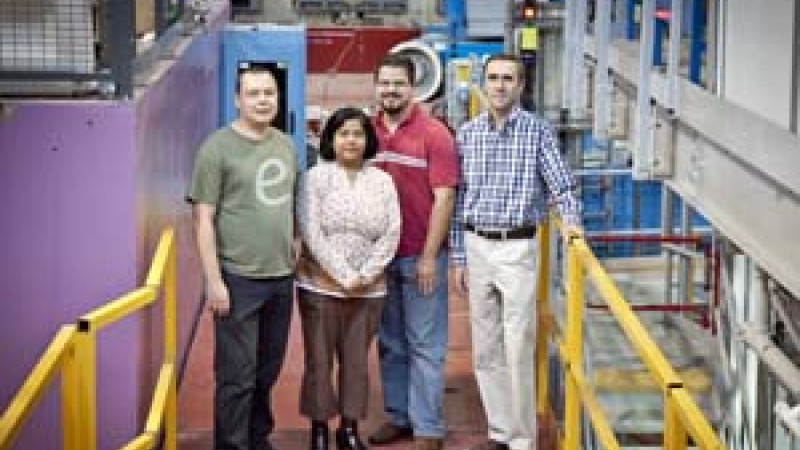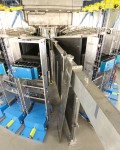When doping a disordered magnetic insulator material with atoms of a nonmagnetic material, the conventional wisdom is that the magnetic interactions between the magnetic ions in the material will be weakened.
However, when the antiferromagnetic insulator barium manganate was doped—a process in which atoms of nonmagnetic vanadium were substituted for the manganese—the barium manganate’s magnetic excitations (i.e., its magnons) were surprisingly unreduced in strength and energy.
Matthew Stone of the Neutron Sciences Directorate and collaborators from Stanford University conducted this research at the SNS Cold Neutron Chopper Spectrometer (CNCS) and Powder Diffractometer (POWGEN). The work will contribute to fundamental understanding of magnetic interactions in insulator materials. “But from what we’re learning one can also apply that to magnets that are used in applications, such as magnets in motors, for example: figuring out how to improve magnets used in devices,” Stone explained in an interview.
“We have a nice model system, the barium manganate (they call it 'Bamno'), that we understand. We’re putting dopants in that system, and we want to see what changes occur. We thought that if we put enough vanadium in there, we would no longer see the known excitations. But it turned out that we could put up to 30% vanadium in there and we still saw those original excitations.”
“That was the main, interesting part of the paper. The extra was that in addition to this excitation known in the original material, and now seen by neutron scattering in the nonmagnetic substituted material, we also see low-energy excitations in these doped materials. And that was unexpected,” Stone said.
Stone and his collaborators used Ba3Mn2O8 powder samples made by Ian Fisher’s research group at Stanford University. For the neutron scattering, they needed the CNCS and POWGEN instruments at SNS. At POWGEN, they were able to “see” the material’s crystal structure. At CNCS, they were able to see the excitations.
“It is very important to know where these vanadium atoms (the dopant) are going. Just because the chemist or the crystal grower mixes two compounds together and puts in a pinch of vanadium, doesn't mean we know that it’s going into the crystal at the right spot,” Stone said. “So POWGEN can show us, as we are putting in more vanadium, that it is it going to the right spot, the right atomic site.”
Then the CNCS instrument measured the magnetic excitations in various dopings of the samples. “What is powerful about the CNCS is that we had five different dopings of material, Stone explained, “and because of the higher flux—the number of neutrons coming in from the neutron source—and the good detector coverage, we were able to churn through those samples very quickly and get reasonable data.”
The magnetic excitations in the pure compound are called “spin dimers”—pairs of interacting spins, strongly coupled together. There are two, hence they are called dimers. The dimers have an energy level, and neutrons then excite the dimers to a higher energy state. In so doing, the neutrons give up energy and slow down. The CNCS instrument measures the neutrons’ energy loss by neutron scattering.
Here is how it works in a model system such as Ba3Mn2O8. “If you put those dimers in a lattice,” Stone explained, “and you have them talking to each other, then you have a dimer excitation that can propagate through the lattice; it is an energy propagation that’s called a magnon. You have a magnetic wave that can move through the material from these dimers that are weakly coupled together in the lattice. The whole crystal is filled with them, and we measure how these excitations propagate. This is called their dispersion relation.”
Enter the doping. The researchers break up some of the dimers by inserting nonmagnetic vanadium into them. Theoretically, the broken dimers can no longer support the magnetic excitations. “Only we found that the propagating magnetic excitation still exists. Even though a third of those dimers may be broken,” Stone said.
The researchers believe their data indicate that something previously unknown is occurring in this doped insulator. “We believe that in this material there are strong bonds, strong dimers, and that these are actually coupled together in a network and that network has many different linkages.
“So one of these linkages in the material, one dimer, actually can see the influence of up to six or eight neighbors. It can see neighbors that are different distances away. And because it can see them, it is still able to propagate its magnetic information along the network, even around one of its neighbors that may have a broken dimer,” Stone explained. “That is why we believe that we still see that magnetic excitation and why we still see that it is disordered.”
Their next step is to get a crystal. The Stanford group will grow the crystal and will align a number of them together to have as large a sample mass in the neutron beam as possible. The measurements will then be taken at CNCS or at the Cold Triple-Axis Spectrometer (CTAX) at HFIR.
“With the powder measurement we are able to see the existence of this magnon and its lower energy and its upper energy. With a crystal we can actually see how it is propagating through the lattice—and with much better detail,” Stone said.
Does this work belong to the superconductivity family of research? It is actually parallel, Stone said. “Superconductor excitation measurements are very similar to the ones we’ve examined. It too is about a magnetic moment that is propagating magnetic information through the lattice. What we call a dispersing magnetic excitation. People measure these in superconductors to figure out what the exchange energy is between magnetic ions in a superconductor.
“We are doing the same thing. Our material is an insulator, but we are doing identical measurements, trying to find out this information about propagating magnetic waves—the same type of excitation in fact that people see in superconductors—in our material.
SNS is funded by the U.S. Department of Energy (DOE) Office of Basic Energy Sciences.
Published Work
M. B. Stone, A. Podlesnyak, G. Ehlers, A. Huq, E. C. Samulon, M. C. Shapiro, and I. R. Fisher, “Persistence of magnons in a site-diluted dimerized frustrated antiferromagnet,” J. Phys.: Condens. Matt 23(2011) 416003 (9pp) doi:10.1088/0953-8984/23/41/416003.









